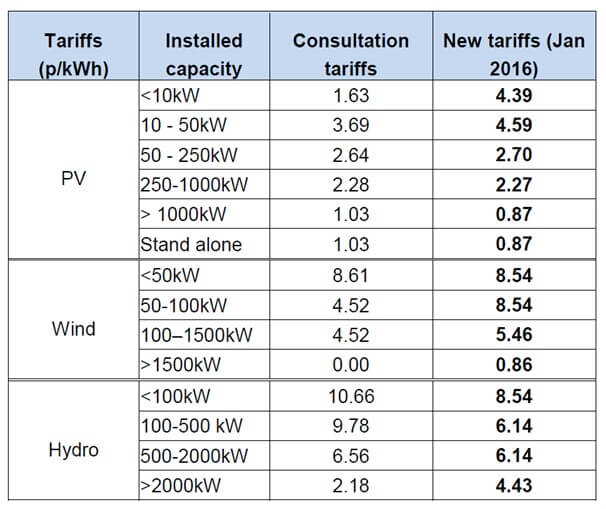The Department of Energy and Climate Change (DECC) launched a consultation on the future of the Feed in Tariffs (FITs) scheme on 27 August 2015. The consultation proposed a number of measures to meet two core objectives: firstly being compliant with the undertaking in the EU State Aid approval requiring that the UK Government review the support offered by the FITs scheme every three years and secondly, following higher than projected levels of deployment, Government set out proposals aimed at controlling the cost of the scheme to limit impact on consumer bills.
FITs has been hugely successful in attracting investment in small-scale renewable electricity deployment, with the scheme currently supporting over 780,000 installations with a total of 4.2 gigawatts of renewable electricity generating capacity across all supported technologies. FITs is funded through the Levy Control Framework (LCF) which is designed to control the costs of supporting low-carbon electricity, paid through energy bills. In 2013 the projected spend for the scheme was set at £1.125 bn, but due to the success of the scheme and significantly higher levels of deployment than anticipated, support for the FITs projects is currently projected to cost at least £1.74bn a year by 2020/21. Action is therefore needed to reduce the predicted impact on consumer bills.
Government recognises the significant role FITs has made engaging non-energy professionals in the electricity market and the role small-scale generation can play in future on a path to subsidy-free deployment. For this reason Government has decided to keep FITs scheme open beyond January 2016. This has only remained possible due to the cost control measures introduced as part of the Government response to the August consultation.
Summary of Decisions
Ensuring better value for money
The consultation proposed new tariffs for solar PV, wind and hydro technologies. Most of the new tariffs provide for a higher rate of return than previously consulted on and, in most cases, the level of support has increase beyond levels proposed. In determining these tariffs, Government believes that the level of incentive offered reflects the cost of deployment whilst remaining within the boundaries of EU State Aid return approval. Under new tariffs, Government is targeting a 4.8% rate of return for solar, 5.9% for wind, and 9.2% for hydro.
Controlling spend
FITs has either achieved (in the case of wind, anaerobic digestion and hydro) or is achieved within the range of deployment (in the case of solar PV) projected deployment levels for 2020/21 from the 2012 FITs Review. The consultation proposed that FITs should be limited to a maximum overall budget of £75m-£100m a year levied from consumer bills by 2018/19 from January 2016, as the maximum that the Government considers affordable within the context of higher than expected spend on the LCF.
Following the consultation and careful consideration to responses received, Government is convinced that deployment caps are the most robust method of controlling expenditure under FITs and that a budget of £100m is appropriate to limit the impact of the scheme on consumer bills.
Looking forward, all new installations for FITs on or after 15 January 2016 will be subject to a new system of caps from 8th February 2016 with the following features:
- Maximum of £100 million a year for new installations by April 2019 from February 2016 divided between technologies and degression bands to set quarterly deployment caps.
- Deployment to be tracked by Ofgem based on the total installed capacity of new installations registered on the Microgeneration Certification Scheme database on or after 15 January and Ofgem’s record of applications for ROO-FIT accreditation received on or after 15 January and ROO-FIT pre-accreditation received on or after 8 February.
- The time and date (to the second) of an installation’s MSC certificate or application for ROO-FIT accreditation or pre-accreditation to be the basis for determining whether or not that installation qualifies under any particular cap.
- A queuing system for applicants who miss out on a cap, meaning that their applications for FITs accreditation are frozen and they have a place in the queue when the next cap opens (but no guarantee of any support until they qualify under a cap).
- A two-speed system for recycling underspend:
- In-year rollover process- any unused capacity for a particular technology and digression band from one quarter gets added to the next quarter; and
- A budget reconciliation for FITs- this would bring together any underspend and, subject to addressing any budgetary pressures, redistribute it as deployment cap ‘top-ups’.
Degression
The consultation proposed two forms of tariff degression tied to the quarterly system of budgetary caps:
- Default degression – proposed with the aim of maintaining a constant rate of return. Therefore, taking into account projected changes to the bill savings and to the costs of installations.
- Contingent degression (retained) – designed to respond to spikes in the level of deployment, indicating deployment could potentially happen with less support and provide better value to the consumer. Two thresholds proposed, 5% when projected levels of deployment are reached and 10% when technology deployment caps are reached. Contingent degression would be in addition to default degression.
Pre-accreditation
On 9 September 2015 Government announced its decision to remove the ability to pre-accredit under the scheme. The rationale for doing this was to maintain a viable scheme for the future, accelerating costs, brought about by higher than projected deployment must be brought under control. However, Government also committed to reconsider re-introducing pre-accreditation if, after consultation, it decided that the proposed new cost control measures could effectively limit potential future impacts on consumer bills.
Government believes that a system of caps, as set out above, does indeed provide increased protection against the risk of over- deployment increasing consumer bills and that re-introduction of pre-accreditation is appropriate, and will be re-introduced from 8 February 2016.
Scheme Focus
The consultation sought views on whether the scheme should be re-focussed towards any particular group or sector. Respondents gave mixed views, with some preferring a refocus towards householders and communities and others showing support to focus the scheme towards specific technologies, with building- mounted solar being the most frequently cited.
Government, however, does not believe re-focusing the scheme at this time meets core objectives to control costs of the scheme. Such a decision may require notification to the EU Commission, a procedure that could introduce significant delay.
Extensions
Government has decided that the right to receive a generous tariff for extensions should be removed for all installations which commission after 15 January 2016. Whilst encouraging the deployment of renewable installations, the scheme should provide better value for money for the consumer, rather that the generator. Extensions may provide generators a tariff that provides a higher rate of return on investment than that set out in the scheme’s EU State Aid approval.
Next Steps for Implementation
The budget agreed for FITs to April 2019 is up to £100m of new spend from January 2016. In order to preserve this budget for future deployment at tariffs which provide better value for money to the consumer, Government intends to implement a pause to the scheme for 4 weeks from 15 January 2016 to 8 February 2016 when the new tariffs and deployment caps will be in place. Government considers a pause of four weeks to be justifiable in an effort to preserve the longer-term future of the scheme.
An amended FIT Order and Licence Conditions Modifications will be laid in Parliament on 17 December 2015. The Order will be subject to a minimum 21 day praying period before it comes into effect on 15 January 2016. The Licence Condition modifications will be subject to a 40 day praying period before coming into force on 8 February 2016.





